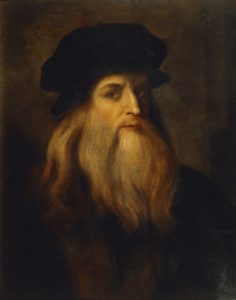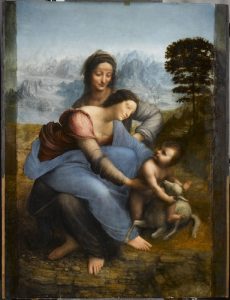Communiqué
New from Ken Burns, LEONARDO da VINCI premieres with part 1 when the Renaissance is in full bloom – “The Disciple of Experience” – Nov. 18 at 8
< < Back toLEONARDO da VINCI
A NEW FILM FROM KEN BURNS, TO AIR ON PBS
NOVEMBER 18 AND 19, 2024
SARAH BURNS AND DAVID McMAHON WRITE AND CO-DIRECT TWO-PART, FOUR-HOUR FILM, BURNS’S FIRST NON-AMERICAN SUBJECT
Original Music Composed by Caroline Shaw and Performed by Attacca Quartet, Sō Percussion and Roomful of Teeth
LEONARDO da VINCI, a new, two-part, four-hour documentary directed by Ken Burns, Sarah Burns and David McMahon will air Nov. 18 and 19, at 8:00-10:00 p.m. (and repeated 10:00 p.m. to midnight) on PBS, PBS.org and the PBS App,
The film, which explores the life and work of the 15th century polymath Leonardo da Vinci, is Burns’s first non-American subject. It also marks a significant change in the team’s filmmaking style, which includes using split screens with images, video and sound from different periods to further contextualize Leonardo’s art and scientific explorations. LEONARDO da VINCI looks at how the artist influenced and inspired future generations, and it finds in his soaring imagination and profound intellect the foundation for a conversation we are still having today: what is our relationship with nature and what does it mean to be human.
The musician and composer Caroline Shaw recorded original music for the film performed by Attacca Quartet, Sō Percussion and Roomful of Teeth. The voice of Leonardo is read by the Italian actor Adriano Giannini. Keith David serves as the film’s narrator.

Set against the rich and dynamic backdrop of Renaissance Italy, at a time of skepticism and freethinking, regional war and religious upheaval, LEONARDO da VINCI brings the artist’s towering achievements to life through his prolific personal notebooks, primary and secondary accounts of his life, and on-camera interviews with modern scholars, artists, engineers, inventors, and admirers.
“No single person can speak to our collective effort to understand the world and ourselves,” said Ken Burns. “But Leonardo had a unique genius for inquiry, aided by his extraordinary skills as an artist and scientist, that helps us better understand the natural world that we are part of and to appreciate more fully what it means to be alive and human.”
The film weaves together an international group of experts, as well as others influenced by Leonardo who continue to find a connection between his artistic and scientific explorations and life today. As the filmmaker and Leonardo admirer Guillermo del Toro says at the beginning of the film, “the modernity of Leonardo is that he understands that knowledge and imagination are intimately related.”
“As we set out to explore Leonardo’s life, we realized that while he was very much a man of his time, he was also interested in something more universal,” said Sarah Burns (MUHAMMAD ALI, EAST LAKE MEADOWS, THE CENTRAL PARK FIVE). “Leonardo was uniquely focused on finding connections throughout nature, something that strikes us as very modern today, but which of course has a long history.”
“Though we follow Leonardo’s personal journey and explore his artistic and scientific accomplishments, we’re also really focused on what went on in his mind and on understanding the depths of his curiosity. To do this we use material from his notebooks mixed with archival film, photos and sound, along with our cinematography and visual effects, and we’re not afraid to stray from the timeline,” said David McMahon (MUHAMMAD ALI, EAST LAKE MEADOWS, THE CENTRAL PARK FIVE). “Leonardo’s thinking was so unique, and in many ways timeless, that our traditional approach alone would have been insufficient.”
Born out of wedlock to a notary and a peasant woman, Leonardo distinguished himself as an apprentice to a leading Florentine painter and later served as a military architect, cartographer, sculptor, and muralist for hire. His paintings and drawings, such as the Mona Lisa, The Last Supper, and the Vitruvian Man, are among the most celebrated works of all time and his art was often equaled by his pursuits in science and engineering.
LEONARDO da VINCI follows the artist’s evolution as a draughtsman and painter, scientist and engineer, who used notebooks to explore an astonishing array of subjects including painting, philosophy, engineering, warfare, anatomy, and geography, among many others. Though he intended to publish his writings, he never did, but the film delves into those he left behind to get inside his mind as he strove to master the laws of nature and apply them to his endeavors.

Credit: Leonardo da Vinci, Musee du Louvre via Art Resource
Leonardo’s personal story is told within the larger context of the Italian Renaissance, a blossoming of art and architecture informed by mathematics and science, and an awareness of the natural world, but also steeped in a renewed interest in classical ideals. In Part One, “The Disciple of Experience,” the film takes us into the world of the bottega, the studio or workshop where Leonardo apprenticed and learned how to prepare paints but would also have discussed math and poetry with his master – the artist Verrocchio – and fellow apprentices. By the age of 20 – in 1472 – he had joined a painter’s guild, whose members were among the most talented artists in Florence, including Filippino Lippi, Domenico Ghirlandaio, Pietro Perugino, and Sandro Botticelli.
Leonardo’s paintings and notebooks tell us much about how he saw the world, as well as the energy and passion he brought to trying to understand it. But we know surprisingly little about his inner life or what he thought about himself and others. Experts, including those in LEONARDO da VINCI, believe he was gay, but he wrote nothing about his sexuality, though homosexuality was for the most part tolerated in Florence at the time.
But we know a lot about how he perceived the outer world. For the dozens of figures who would populate an early unfinished painting – the Adoration of the Magi (1481) – he sat in the piazzas of Florence, observing and sketching. “You must wander around, and constantly, as you go, observe, note and consider the circumstances and behavior of men as they talk, quarrel, laugh or fight together,” he wrote. In the lower right corner of the unfinished painting, a young male figure, most likely Leonardo himself, gazes away from the dramatic center.
Leonardo would abandon that work, as he would many others. Another painting from that time – Virgin of the Rocks – depicts the Virgin Mary and her son, a common theme of Renaissance paintings. But unlike other paintings of the period, Leonardo’s Mary exudes a natural, maternal instinct, human and spiritual at the same time. “Absolutely the most complex Madonna image of the entire Renaissance,” the art historian Monsignor Timothy Verdon says. “Its complexity lies in a probing effort to understand a deep mystery.”
Leonardo worked on the painting in Milan and would soon win the patronage of Ludovico Sforza, the ruler of the Duchy of Milan. Leonardo would spend 18 years in the city and would produce some of his most famous works there. In a studio provided by his patron, he painted portraits, drew futuristic machines, and made observations in dozens of notebooks. The notebooks, which were written in a backwards script, so as not to smear the ink as he wrote with his left hand, provide us with key qualities of who he was. “It’s not just that Leonardo knew an awful lot,” says biographer Charles Nicholl, “It is that he found out an awful lot.”
Leonardo often sought wisdom from ancient philosophers and scientists, including Aristotle and Galen. He also found inspiration in a treatise by Vitruvius, a Roman architect, who wrote about the symmetry between the human body and a skillfully designed temple. The treatise led Leonardo to produce the drawing the Vitruvian Man. As the Italian art historian Francesca Borgo explains in the film, “One of the most celebrated examples of a dialogue with ancient scholars, possibly even an attempt to surpass classical civilizations, is undoubtedly the Vitruvian Man, one of the most famous drawings in Western art.”
Sforza would choose Leonardo in the early 1490s to prepare a mural for the dining hall of a monastery. He assigned the artist a suitable scene given the location, The Last Supper.
The painting, which still adorns the wall today, was his most ambitious to date – an opportunity for him to prove his ability as a painter. When finished, the mural rose to 15 feet in height and spanned 29 feet across the wall. It showcased Leonardo’s gift for blending tones and colors, his mastery of light and shadow and his command of geometry, which he wielded with great precision to bring harmony to a moment of chaos. Leonardo da Vinci had brilliantly rendered the gestures – both subtle and dramatic – that testified to the psychological states of his subjects.
The broadcast of LEONARDO da VINCI will be accompanied by educational materials for middle and high school classrooms, highlighting recent research and perspectives. The materials will be available at the Ken Burns in the Classroom hub on PBS LearningMedia. These materials include media-rich resources, including videos, primary sources, and classroom materials to allow grade 5-12 educators to easily bring the materials into their Social Studies, English Language Arts, and Science classrooms. Resources will present opportunities for educators and students to explore the film’s key topics and themes, including Leonardo’s innovative spirit and his wide-ranging accomplishments against the backdrop of Renaissance Italy. UNUM, Ken Burns’s website that looks at the connections between the past and current events, will also utilize other films from the Florentine Films library to facilitate conversations about major themes from the film.
LEONARDO da VINCI will be available to stream on all station-branded PBS platforms including PBS.org and the PBS App, available on iOS, Android, Roku streaming devices, Apple TV, Android TV, Amazon Fire TV, Samsung Smart TV, Chromecast and VIZIO. The series will also be available to stream on PBS Passport and the “PBS Documentaries Prime Video Channel.” PBS station members can view the documentary via PBS Passport as part of a full collection of Ken Burns films. For more information about PBS Passport, visit the PBS Passport FAQ website. LEONARDO da VINCI will be distributed internationally by PBS International.

